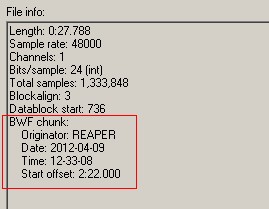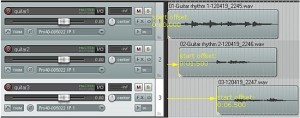BWF (Broadcast wave format) is simply an upgraded version of the standard WAV file (lossless). In BWF format, a user can add non-audio information to the WAV file such as text. This information can be associated to the nature of the recording. It can be the name of the engineer, date of creation, timing/synchronization information, etc. There is however a limit as to what you can add and most standard DAW would provide text fields for convenience in filling up this information.
How to check if you are dealing with a broadcast wave format?
Take note that the broadcast wave format file extension is still .wav. So by file extension you won’t be able to distinguish whether that file is a BWF. The only way to check is to confirm through WAV file properties inside your DAW.
Follow the steps below:
1.) Load/import or insert the WAV file in your digital audio workstation. In this example, let’s use Reaper.
2.) Select any of the audio waveform in your project (you can check them one at a time).
3.) Go to Item — > Source Properties.
4.) In the properties, if you are able to see the text information under “BWF chunk”, then the WAV file is using broadcast wave format such as this:
Reaper by default will use broadcast wave format when you are recording and saving the tracks to the hard drive. As you can see on the above information, the date and time as well as the “start offset” has been provided. These are the most basic information that you can get from a BWF file.
What is “Start Offset” and why it’s very important?
Start offset is defined as the start time of that specific BWF file in your multi-track projects. This is a very important piece of information in synchronizing your tracks in a multi-track project regardless of any DAW.
For example, say you recorded 3 guitar tracks in Reaper. By default, it will be assigned with a “start offset”. And supposing below are the start offset data taken from the BWF chunk.
Guitar1: 0:00.000
Guitar2: 0:01.500
Guitar3: 0:06.500
These are visualized as follows in your Reaper session:
Start offset is referenced from time 0, which is the start of the multi-track timeline. These data is also called “timestamp” in other DAW. There are other methods on making your recordings compatible with any DAW. But using BWF is the best solution if this feature is fully supported by your DAW or recording software.

